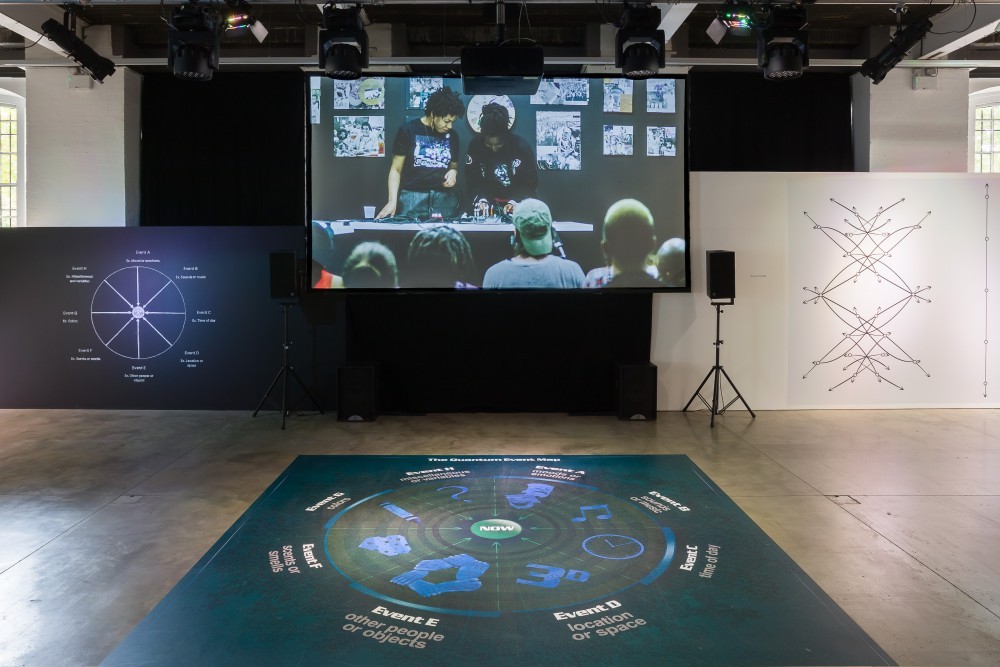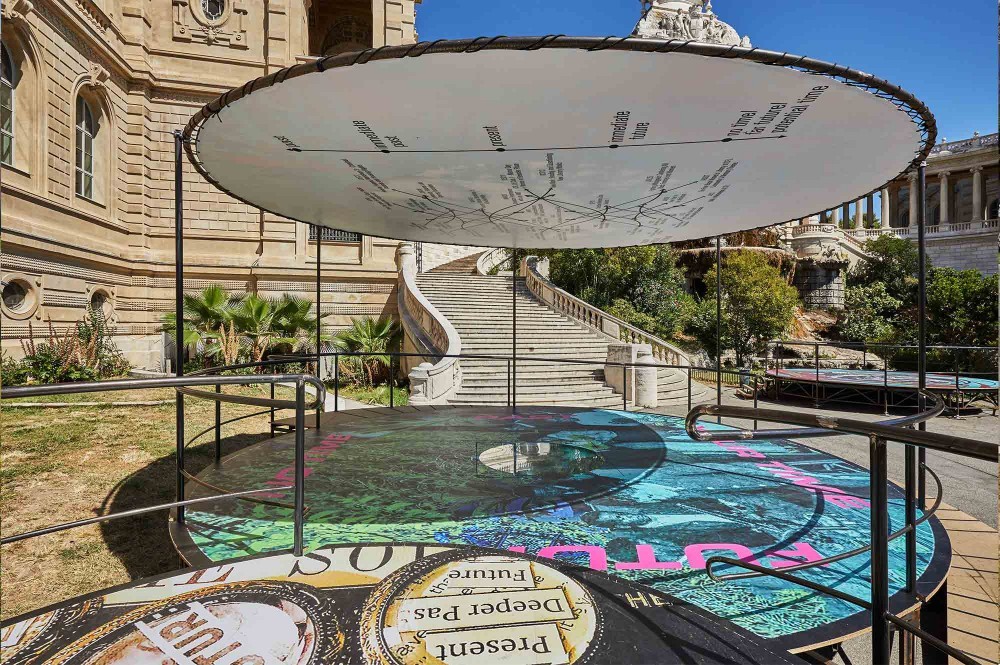
Black Quantum Futurism: ‘Black Diasporan temporalities share many parallels with quantum principles’
Black Quantum Futurism are the recipients of the Collide Award. We spoke to the artists about their ideas that link quantum physics and Black/Afro traditions of time, and their research project CPT Symmetry and Violations, which they will develop during their upcoming residency.
How did Black Quantum Futurism come about?
We have worked on creative projects and events together for about ten years. One of our first 'formal' projects together was Camae producing a soundscape for Rasheedah’s first self-published book of interconnected short time travel stories called Recurrence Plot (and Other Time Travel Tales) in 2014. Then, Rasheedah wrote a zine and essay for an album of Sun Ra song remixes that Camae created. We really enjoyed the collaborative process of thinking about how the time travel mechanisms used in the book translated into sounds and how sound and music worked as a form of time travel in its stimulation of memories, and the process of finding or creating sounds that matched the tones and energies of the words. We then evolved into performative readings by Rasheedah with live sound experimentation by Camae and visual projections.
We are both writers, and we each have a distinct way of writing and expressing. Rasheedah brings a speculative fiction perspective and context to her writing and experimental essays. As a poet and rapper, Camae has a certain lyrical quality about her writing. Camae also produces music (Moor Mother), and both of us delve into visual art in different ways, but there are so much cross-contamination and sharing. Through Raseedah’s legal work, she looks for ways to uncover the role that time plays in the justice system for marginalized Black communities and the role of time as an economic commodity in Western society. Raseedah has made this an explicit part of her advocacy as a housing attorney and through civic engagement activities as a community member and advocate.
We both have a deep interest in quantum physics, time, and time travel, as well as an interest in researching Black and Afrodiasporan cultural traditions and religions. Black Quantum Futurism was a way for us to create artistic projects and do research at the intersections of all of those interests.
Through our shared work as Black Quantum Futurism, we develop practical tools for allowing access to pasts or futures so that linear temporality and obedience to mechanical and digital clock time cannot. Alternative temporalities can inform legal perspective, legal rights, and the impact of future law-making on poor and historically marginalized communities. For example, our project Community Futures Lab allowed us to open a year-long community space where we developed and practised a framework called community futurisms. This project aimed to facilitate a deeper understanding of the dynamics, rhythms, temporalities, memories, histories, and ideas for the community’s shared futures, primarily through creative and informational workshops and “oral futures” interviews.
Afrofuturism’s concept and community have developed over the last 20 years as a tool and lens that marginalised black communities in the diaspora use to shape their own futures. How did your interest in Afrofuturism start?
Before BQF, Rasheedah created The Afrofuturist Affair (AFA) in 2011, a grassroots organization to form a Philadelphia-based community for and with Black people. AFA produced Afrofuturistic and speculative creative work and aimed to make Afrofuturism more accessible to marginalized Black communities. Starting as a singular event in Philadelphia – a mutual aid fund and costume ball– AFA evolved into other collaborative and creative events around the country and the world, including free workshops, critical, creative writing, social media actions, promoting and supporting Afrofuturistic culture, practice, and events around the diaspora.
At that time, Afrofuturism was mostly discussed in academic spaces and artistic circles. The AfroFuturist Affair was specifically formed in response to local needs–the lack of a local conversation on and a local outlet for Afrofuturism, the lack of access to the predominantly white science fiction community in Philadelphia, and the disconnect between academic Afrofuturism and practical access to it for marginalized Black communities. Afrofuturism prompted us to think about alternative temporalities, how time imprints itself on communities, and how time plays out in the lives of marginalized and oppressed people who have uneven access to both their histories and their futures. We have developed our work and knowledge on the topics of time, temporality, and Afrofuturism. We have intentionally used our expertise to develop local leadership and projects focused on Black futurism in Philadelphia’s most marginalized communities.
How do quantum physics and Black/Afro cultural traditions of consciousness, time, and space overlap in your practice?
In our work, we focus on the future’s temporal domain and how it can be shaped or reconfigured by Afrodiasporic ontology and existence. Time and temporality, as explored through BQF, consist of multiple dimensions—not just mechanical, linear, clock time, or other conventional and historical measures. Based on our extensive research, Black/Afro Diasporan temporalities and traditions of time share many parallels with quantum principles: the past intermingles with the present, interwoven with the future(s).
Time in Black/Afro Diasporan traditions is alive, dynamic, and textured. Past and future variables can be held in superposition, existing in their infinite states of possibility, open to influence, collapsed into reality, and uncollapsed back into superposition at will.
Black Quantum Futurism uses clocks and maps to deconstruct and dismantle hegemonic Western Spacetimes. We create maps that embrace the inherent tensions between space and time and provide opportunities for reconfiguration. For example, our practice includes mapmaking - housing journey maps, sonic mapping, and communal memory mapping. This includes a map inspired by Afro-diasporic cultural practices and perspectives on time and space, bringing together the micro (or quantum) events that like to “happen in time together” to construct future moments/events or re-examine past moments/events as individuals or as groups and communities.
In your research proposal, CPT Symmetry and Violations, you pointed out and drew an analogy between two different meanings of the acronym CPT: Charge, Parity, Time reversal symmetry and Coloured People’s Time. What do you seek to explore in this project during your time at CERN and Barcelona?
In physics, CPT Symmetry is a fundamental symmetry of physical laws that holds for all physical phenomena. The acronym also carries another meaning in the phrase “Colored People’s Time.” CPT, in that sense, is often used as a negative stereotype to refer to Black people as being chronically late. In a published essay called 'Dismantling the Master’s Clock' and a few other papers, our work analyses explicitly Colored People’s Time as a split spatio-temporal consciousness and traces it back to an ancestral reckoning of time and a current-day survival mechanism.
Taking the double meaning of CPT as Colored Peoples Time and as Charge, Parity, and Time Reversal, we want to examine at CERN time and temporality at various scales and dimensions - personal, interpersonal, communal, global and cosmic.
Through the intersections of art and science, our project will explore what it would mean to understand or experience the non-linearity or subjective nature of time as part of global or local timekeeping and calendaring methods. Additionally, it seeks to investigate how our concepts and experiences of time can be widened by a broader recognition of time as variable and significantly impacted by one’s community and cultures.
Our world is shaped by the adherence to Western linear time, or what BQF theory calls 'the master clock'. In your multidisciplinary artistic practice, you have developed temporal technologies to question this notion. How might these technologies influence our ontologies of time? What do you plan to develop further during your residencies?
Our visual, written, performance, installation, and sonic work unpacks and traces the future's history and the lineage of linear futures as a colonialist tool. Hierarchies of time, inequitable time distribution, and uneven access to safe and healthy futures inform intergenerational poverty in marginalized communities in some of the same ways that monetary wealth passes between generations in privileged communities.
Our installation series 'bio clocks' seek to challenge how we engage with clock time. Created by artist Madam Data and additional clocks developed in collaboration with BQF, the bio clocks are motion and sound censored. For a recent exhibition at Manifesta 13 Biennale Marseille, we created a large-scale bio clock as part of a communal stage in front of Palais Longchamp. Consisting of three entangled circles, this sculpture come stage was designed using cosmograms – simple geometric systems for depicting the cosmos found in various cultures throughout the world. Conceived as an interactive space, it responds to each visitor’s movements through a series of dials, synchronizing individual and collective movements through time. This platform gave voice to varying communal, personal, and global temporalities, spatialities and identities. The dials were motion censored and spun to point at different time dimensions (i.e. past, present, future) instead of numbers. We want to continue developing this series, informed by research done at CERN on CPT symmetry.
The artists that come to CERN bring different approaches, and the dynamics between artists and scientists follow unexpected paths. What do you expect from your time in the laboratories and your exchanges with the scientific communities?
We are interested in learning more about the Large Hadron Collider experiments' implications that consider a range of scales of time, from wormholes and black holes to quarks and particles. Having an opportunity to work with the scientists at CERN and to be in Geneva, given its rich history of time, bells, and clocks would give us unprecedented access to information, materials, and imagery to advance our work. We hope to use photography, recorded interviews, field sounds, and on-site footage from the laboratories to incorporate into our intermedia works (songs, short films, digital art).
How do you envision the future?
In the future, the past and future are not cut off from the present. Both dimensions influence the whole of our lives, who we are and who we become at any particular point in space-time. In this future, we have dismantled oppressive, hegemonic temporalities and timelines and developed, recovered, and synthesized healthy alternative temporal dynamics in our communities and the world.
We see this work as cyclical, ongoing, dynamic, generative, and generations-long. We project a vision of our shared future(s) where we have actively begun to address how future(s) are made inaccessible to marginalized communities in general and Black people in particular. We have developed positive futurity concepts and sustainable technologies of joy that benefit low-income, vulnerable, and marginalized communities. We see “in the future” an active engagement with temporalities and alternative temporal orientations - to quote Rifkin, “the new time rebels advocate a radically different approach to temporality.”
Interview by Ana Prendes, Communications and Content Producer at Arts at CERN.





